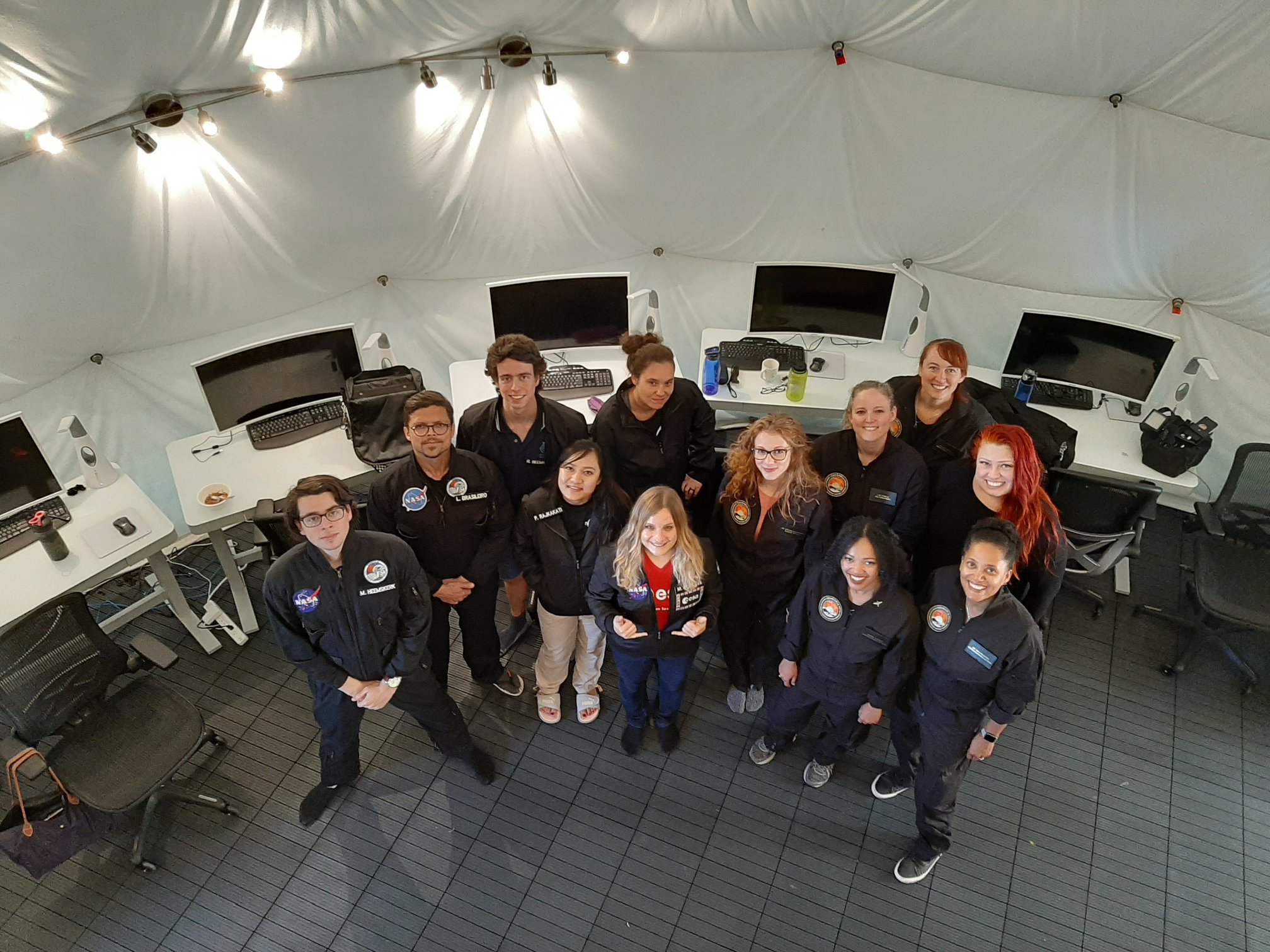European scientists are taking a mock moon mission in Hawaii right now
Mauna Loa, Hawaii — A crew of researchers prepared to leave "Mars" this past Saturday (Jan. 18) as another crew arrived, ready to explore the "moon."
The members of the Sensoria I crew ended their two-week analog "Mars" mission Saturday in the HI-SEAS (Hawaii Space Exploration Analog & Simulation) habitat, which is located on a remote slope of Mauna Loa on the Big Island of Hawaii. But before they left to return to "Earth," a new crew of researchers arrived, ready to begin a lunar analog mission.
This new, lunar crew is embarking on the third EuroMoonMars mission — a series of missions running in collaboration with the European Space Agency, the International MoonBase Alliance and HI-SEAS, Michaela Musilova, the director of HI-SEAS, who is also serving as the commander of this mission, told Space.com.
Related: Life on Mars: Inside The HI-SEAS Isolation Habitat (Gallery)

Arriving on the moon
The crew arrived through the habitat's airlock. The Sensoria I crew met them in the habitat with warm greetings and a "space lunch" of shelf-stable "astronaut food," including vegetarian chilli, rehydrated cheese, lentils and garnished with some greens that were grown inside the habitat. (It was pretty delicious!) But, the convergence of the two crews was more than an exciting, morale-building meeting. The overlap created an opportunity for the Sensoria crew to train the new crewmembers and help them figure out how to live off-Earth.
"The Sensoria crew will train the incoming crew, teach them everything that they learned during their time on Mars, but in the same station that this crew will be using for a lunar simulation," Musilova said.
The new crew got a crash course in how to cook and eat in the habitat's little kitchen, how to use the medical bay, use energy in the most efficient way and even how to use the hab's specialized bathroom. (Apparently, as the Sensoria crew told Space.com, going to the bathroom "on Mars" can be a little bit tricky.)
Get the Space.com Newsletter
Breaking space news, the latest updates on rocket launches, skywatching events and more!

Like all HI-SEAS crews, to save resources like water and energy, the new crew of Analog astronauts will have to adhere to a series of strict guidelines and will be monitored by and communicate with HI-SEAS Mission Control, which is located on the Big Island of Hawaii away from the habitat. The crew will have to keep a close eye on energy consumption, especially because, since the hab is solar-powered, storms can drastically deplete available energy. The crewmembers will also have to limit their water use. Each person is allotted only 8 minutes per week (yes, per week) of shower time. However, the new ESA crewmembers brought a metal bucket with them in hopes of making the most of their bathing water.
A quick peek inside the hab as the Sensoria I crew moves out and a new crew from the ESA moves in! More videos/etc. to come soon 😘✨🚀@SPACEdotcom pic.twitter.com/AL9sVrSzM8January 19, 2020
Exploring the moon
In addition to Musilova, the crew is made up of five young researchers who are all embarking on their first analog missions.
Kyla Edison, a native Hawaiian from the island of Kauai who works as a geology and materials science technician at PISCES (Pacific International Space Center for Exploration Systems) Hawaii, will work to sample lava flows surrounding the habitat. Edison will characterize the minerals in these samples and, using a miniature, high-temperature kiln, create materials using the "lunar" resources local to the habitat site. This work will test if analog moon/Mars materials could be used to make usable construction materials on future missions.
"I'm looking at using them for launch pads, foundation work and solar radiation shielding," Edison told Space.com, referring to the construction materials she will be working to create.
Priyanka Das Rajkakati will serve as the crew executive officer and commander-in-training for this mission. An aerospace engineer and artist, Das Rajkakati is currently pursuing a doctorate in GNSS (Global Navigation Satellite System) technology. During this mission, she will conduct robotics experiments, study navigation and mapping techniques, train under Musilova and hopefully one day assume the role of commander. She will also be working on visual art projects, testing a brainwave-measuring device and studying crew psychology.
Related: One-Year Mock Mars Crew 'Returns to Earth': HI-SEAS Photos
Habitat tourin' @SPACEdotcom ✨🚀 pic.twitter.com/YO4rDsXCuyJanuary 18, 2020
Marc Heemskerk, the lead scientist for the mission, is an earth scientist from Vrije Universiteit Amsterdam, who specializes in in-situ resource utilization. On Earth, Marc Heemskerk studies lava tubes, and on this mission, he will continue studying how humans may one day live and settle on the moon.
Marc's brother, Robert Heemskerk, will also be on this mission. With a mechanical engineering background, Robert Heemskerk will work with four different rovers at the habitat site throughout this mission. He will not only test the individual rovers but also will thoroughly explore how the rovers might work together and assist one another, testing the capacity for robot-to-robot cooperation off-Earth.
Last, Lucas Brasileiro, an aerospace engineer and doctoral student at the Université de Technologie in Troyes, France, joins the crew. On this mission, Brasileiro will work to test a steel drill bit for drilling operations on difficult surfaces, exploring how such a bit might work in off-Earth circumstances.
- The 9 Coolest Mock Space Missions
- One-Year Mock Mars Crew 'Returns to Earth': HI-SEAS Photos
- Mars500: Photos From Russia's Mock Mars Mission
Follow Chelsea Gohd on Twitter @chelsea_gohd. Follow us on Twitter @Spacedotcom and on Facebook.

Join our Space Forums to keep talking space on the latest missions, night sky and more! And if you have a news tip, correction or comment, let us know at: community@space.com.

Chelsea “Foxanne” Gohd joined Space.com in 2018 and is now a Senior Writer, writing about everything from climate change to planetary science and human spaceflight in both articles and on-camera in videos. With a degree in Public Health and biological sciences, Chelsea has written and worked for institutions including the American Museum of Natural History, Scientific American, Discover Magazine Blog, Astronomy Magazine and Live Science. When not writing, editing or filming something space-y, Chelsea "Foxanne" Gohd is writing music and performing as Foxanne, even launching a song to space in 2021 with Inspiration4. You can follow her on Twitter @chelsea_gohd and @foxannemusic.









